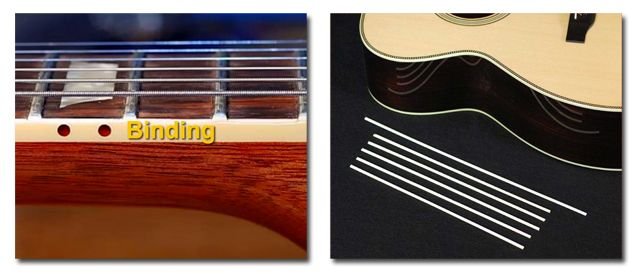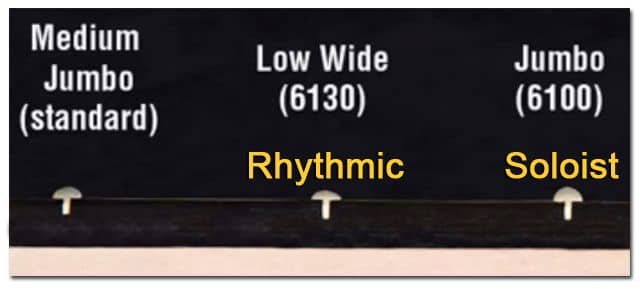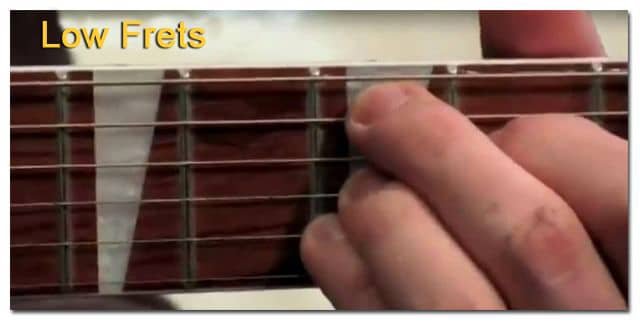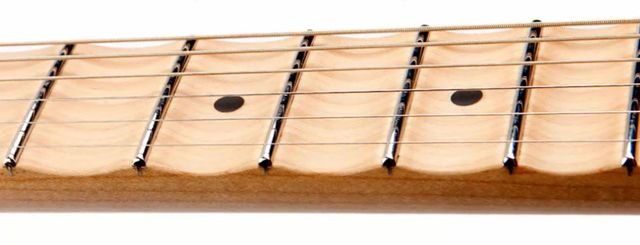Characteristics of the Different Types of Frets for Electric Guitar: JUMBO, MEDIUM, and SCALLOPED Fretboards. Height and Thicknesses.
The type of fret that our guitar mounts greatly influences the touch of the instrument, and its benefits for performing different techniques on the guitar.
It is very important to hit the frets that most interest us when buying a new guitar, since changing frets is expensive. Especially if the fingerboard of the guitar is varnished, or if the neck has a binding on both sides of the fingerboard.

If you are wondering what the use of binding is, I will tell you that apart from the fact that it costs more to change frets, it also provides a decorative touch, and also has a protective function against light blows, by strengthening the edges of the guitar.
Guitar Frets: Different Fret Sizes
A guitar can acquire certain characteristics depending on the type of frets it has mounted, or its use can be oriented as a rhythmic, soloist, or all-terrain instrument.
High Frets
The higher the fret, the more volume and sustain it will provide, and it favors slurs such as “hammer on” or “pull off”. It also favors the speed of execution, and the realization of bendings, due to the lack of contact or friction, of the fingers against the wood of the fretboard.

Another advantage of high frets is that obviously its durability increases compared to another type of lower and narrower fret. Consequently, we will be able to level a high fret more times than a lower one, before definitively changing them if necessary.
A high and thin fret is detrimental when it comes to sliding the fingers. For this reason, the high frets are usually also wider, to facilitate sliding.
Something to keep in mind with the high frets is to know how to moderate the pulsation of the strings, so that the notes do not sound out of tune due to an overly energetic pulsation.
Low Frets
On the other hand, the low and narrow frets favor the sliding of the fingers, facilitate the placement of chords, and the tuning of the notes is optimized when pressed. Since the wood of the fingerboard will act as a stop when pressing. For these reasons, this type of fret is more commonly used on rhythm guitars.

Guitar Frets: Fret Wear
The sliding of the fingers is impaired when the fret loses its roundness, due to wear. Due to this erosion, the fret is flattened at the top, and slight edges are created on both sides of the fret.

This problem will be solved with a simple crowning of the frets, so that they recover their rounded shape again.
Medium Jumbo Guitar Frets
At first, low and narrow frets were usually installed on electric guitars, since they tried to favor performance as a rhythmic instrument, such as Rickenbacker guitars. Precisely Rickenbacker is one of the few brands that continues to mount low and narrow frets on its guitars.
But currently the vast majority of brands mount higher frets, mainly frets medium jumbo.
This type of fret is in a balanced area that increases the versatility of the instrument. The medium jumbo fret works well for all kinds of playing techniques, including bending, slurs, tapping, soloing, and rhythms.
Frets higher than the medium jumbo, would be for a guitar intended primarily for solo styles. And lower frets than medium jumbo, they would be geared towards rhythm guitarists.
Badly Finished Frets
Something very common in guitar manufacturing is the lack of meticulousness in finishing off the ends of the frets. An auction that requires time, and will undoubtedly raise the final price of the instrument. But annoying edges can also be generated at the ends of the frets, which will make it uncomfortable for the hand to slide down the neck.

To smooth these edges we can round off the end of the fret a bit, with a precision file. But first we must tape the neck with masking tape, so as not to damage the varnish or the wood. If the tape were to break when using the file, we would have to cover the exposed part again with tape.
Even so, we should perform this operation carefully and without haste. Since it is a meticulous job, and there are many frets to file. So patience will be our ally to be able to do an optimal job.

After applying the rounding with the file, we will have to go through the end of the fret a 600 grit sandpaper to smooth the surface, and then a 1000 grit sandpaper to finish. To recover the shine, we carefully apply a metal polish with a cotton ball, before removing the masking tape.
Scalloped Fretboard
For the total absence of contact of the fingers with the fretboard, we have the scalloped fretboard, with a concavity to move the wood away from the guitar strings.

This concavity is beneficial for tapping techniques, but it is not necessary to scalloped the entire fingerboard for this. Would be enough reducing the wood only in the last frets of the guitar, for example from the 12th or 15th fret. (Ibanez KIKO100).

We can also find fully scalloped guitars, like the Fender Yngwie Malmsteen, with Seymour Duncan YJM pickups, and bronze nut (image above).
A fully scalloped fretboard forces us to play very smoothly. We only have to press the strings just enough to make it sound. Consequently, we would have to adapt to handling a fingerboard of this type, if we do not want the notes to sound out of tune due to excessive pressure from the fingers.
But in reality what makes us fast is the softness in the pulsation of the notes of the fingerboard, even more than the scalloped. We can be very fast on unscalloped tuning forks, if we maintain a very subtle pulsation of the notes.

Don’t expect to pick up a scalloped guitar and just fly, because at first you’ll notice the strange neck, and we’ll need some time to get used to it.
Scalloped is also beneficial when bending string at the top of the neck. But things get complicated when it comes to placing chords with ease.
If we have several guitars we can send one to scallop. Or try to do it yourself with curved files, rounded blocks with sandpaper, and a large dose of patience. Because if not, we may have a failure.
